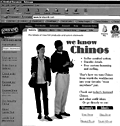

|
Faces Behind of the Internet Economy Layer One – Infrastructure
Layer Two – Applications
Layer Three – Intermediaries
Layer Four – E-commerce
|
Layer One – Infrastructure
 Freei.Net
Freei.Net
Steve Bourg, chief technical officer
www.freei.net
Paving the Internet Freeway
There’s no such thing as a free lunch, but a significant number of high-tech products seem to be readily available
for nothing these days. From free PCs to free software, companies are recognizing that sometimes you can make
more money giving your product away - if in exchange you receive access to volumes of valuable demographic
data.

Poised to take broad advantage of that reality, Freei.Net is one of the first major free Internet Service Providers (ISP), offering Internet access in exchange for demographic information used to target banner ads displayed during on-line sessions.
In a market constantly in search of what the New York Times recently called “the new new thing,” Freei.Net is one of the companies changing the way we think about the Internet. Every 12 seconds, Freei.Net acquires a new subscriber, and 17 percent of those subscribers are new to the Internet. By opening the Internet economy to those unwilling or unable to pay the monthly fees of a traditional ISP, Freei.Net is expanding the E-commerce customer base. “Freei.Net is not just increasing Internet access,” said Steve Bourg, chief technical officer, Freei.Net. “We are acting as a catalyst for E-business.”
At 22, Bourg is not your typical CTO. Growing up on Microsoft’s doorstep, his ideas about careers and the future were shaped from the onset by an unusual set of assumptions. He left school early to manage technology projects at Home Mortgage USA and sees formal education as less important than hands-on experience in the high-tech world. “I’ve always loved software development,” he explained. “But the things I wanted to learn weren’t in books - technology changes too fast. My goal was to compete with Bill Gates. I wouldn’t call it a specific plan of attack, but that was the general idea.”
That general idea combined with Bourg’s enthusiasm and drive made him the ideal partner when Bob McCausland, Freei.Net’s CEO and the owner of Home Mortgage USA, went looking for an Internet business venture. The two spent several months talking over the opportunities and began developing software for Freei.Net in June 1998. The company went online in Washington on December 1, 1998, and by April had expanded its services to Los Angeles, San Francisco, Chicago and Washington, D.C. In early October, Freei.Net closed a deal with a major shared modem provider that will give the company coverage in all 50 states.
The Internet economy has allowed a younger generation to accomplish amazing things at an early age. At Freei.net, the average age of the development team is between 18 and 22. All of them work exceptionally hard under extreme deadlines, but seem to thrive on the pressure. “The Internet is the place to be for young entrepreneurs right now,” said Bourg. “You need to take on projects aggressively and take advantage of the opportunities. The workload is immense, but the potential financial rewards are enormous.”
So far, Freei.Net is definitely on its way to the kind of financial success Bourg and his team envision. The company’s business model, which seems fairly simple on the surface, has a number of key details that set Freei.Net’s service apart. For one thing, it collects only anonymous demographic data, which increases the comfort level of users. The company has focused on some of the services that made AOL successful, including online chat. “The goal is to take on major providers like AOL,” explained Bourg. “Our infrastructure costs are a lot lower, which gives us a bit of an advantage, but it really comes down to offering the best product. We need to provide cutting-edge services if we’re going to pull ahead.”
Ultimately, the factor that determines Freei.Net’s success will be subscriber volume. With goals of two million subscribers by the end of the year and eight million by the end of 2000, Bourg sees free Internet access as the gateway to building a truly universal “World Wide Web.” “Letting advertisers pick up the costs for access provides a real benefit to the consumer. We hear from subscribers who went out and bought new computers the day they found out Internet access was free. We’re bringing new users onto the Internet every day.”
There may never be a day when someone will give you a free lunch in exchange for personal or demographic information. But as Freei.Net’s success shows, universal access to the Internet is a very real possibility. And that may be the greatest technology revolution of all.
For additional information on FreeiNet, contact:
Bridget Murtagh, public relations at 253-796-6500 (or) bmurtagh@freei.net
 Verio, Inc.
Verio, Inc.
Sean Brophy
Vice President of Corporate Development
www.verio.com
Building Globally, Servicing Locally
The weathered phrase ‘think globally, act locally’ has been re-purposed by many organizations over the past
decades. But for Englewood, Colorado-based, Verio, Inc. (NASDAQ: VRIO), a national Internet Service Provider (ISP)
and Web services firm, the commitment to ‘build globally and service locally’ is at the core of their business strategy
to service the small and medium-sized enterprise (SME) marketplace. The three-year old company has been buying
up local ISPs throughout the U.S., building a formidable national network while establishing a strong local presence
in each business community.
“Our national scale is vital to the quality of our local service,” said Sean Brophy, vice president corporate development, Verio. “The economies of scale enable us to build the best network and offer the best packaged products at the best prices.”
Verio posted 2nd quarter revenues in 1999 of $62 million. “Last Christmas was the bellwether for e-commerce,” said Brophy, in regards to Verio’s stunning growth. “So many people tried and liked doing business online that people came to us in droves wanting to get their business online.”
And the future only looks brighter. The ISP and Web hosting markets are growing by leaps and bounds. According to International Data Corporation, total ISP and enhanced services (including Web hosting) revenue in the U.S. are projected to hit $18.3 billion and $7 billion respectively in 2000.
Yet other metrics provide more meaning for Verio, especially the savings and opportunities their services provide for the SME marketplace. Verio estimates that it would cost a small business at least $5,000 in hardware and software, not to mention the labor, to assemble an e-commerce offering that Verio can provide starting at $35 a month.
By leveraging the Internet, Verio provides the chance for small businesses to participate in a previously inaccessible level of the economy. “We are enabling innovative people who would normally need a large amount of capital to get their business connected to have a very strong Web presence with very low capitalization,” explained Brophy.
Providing connectivity for their customers is just the beginning for Verio. The company provides and manages over 800,000 email boxes, creates and hosts over 265,000 Web sites, and builds and manages e-commerce solutions. “The last thing a SME business wants is three different Internet / E-business partners to come in and provide a cobbled solution,” said Brophy.
Verio prides itself on allowing SME companies to focus on what they should - their business - not keeping their Internet infrastructure up and running. Verio views the Internet economy as a way to liberate companies from the burden of managing complex IT infrastructures. “Today you can conduct business with anyone anywhere in a much more frictionless fashion,” said Brophy. “It’s not about having to be a great IT company to be successful, but relying on others to help you with the IT so a company can focus on their core competencies of building a business.”
Brophy also believes the increasing trend of application outsourcing will continue to grow as all the software components of a company’s business move to the Web. “Email, Web sites, and e-commerce were the first things to be ‘Webified,’ now finance, human resources, payroll, and ERP applications are moving to the forefront. In the future, businesses will essentially outsource all of their IT systems to a company like ours who provide robust data centers with a competent IT staff to monitor the applications.”
Thinking and building globally is exactly what Verio has in mind. In addition to the multi-billion dollar projections for ISP and Web hosting in the U.S., Brophy believes the European market is about 18 months - two years behind the U.S. in its adoption of the Internet and Verio is strongly positioning themselves to be a major player in that market. Verio already hosts over 50,000 Web-sites in Europe, which makes them the largest host of domain-based Web sites on both sides of the pond.
“The demand for application outsourcing and Web hosting services is just beginning to take off,” explained Brophy. “If you’re thinking as optimistically as we are about the Internet’s potential to affect every business and industry, our business is just getting started.”
For additional information on Verio, contact:
Matt Bell, corporate communications at 303-645-1961 (or) mbell@verio.net
Layer Two – Applications
 eCode.com
eCode.com
Laurent Gharda, chief operating officer
www.ecode.com
Managing Your Internet Identities
Moving isn’t fun. Everyone knows the process doesn’t end with unpacking your belongings. It takes months to get
updated information to banks and credit card companies, and magazine subscriptions seem to surface just as you
are about to move again.  In an age where people change jobs every 18 months and move every three years, how
do your friends, colleagues, and service providers track you down without getting lost in a paper trail of outdated
information? eCode.com, a Sunnyvale, CA - based Internet start-up has the answer: a Universal Internet Identity.
In an age where people change jobs every 18 months and move every three years, how
do your friends, colleagues, and service providers track you down without getting lost in a paper trail of outdated
information? eCode.com, a Sunnyvale, CA - based Internet start-up has the answer: a Universal Internet Identity.
Rohit Chandra, the 30 year-old founder and CEO of eCode.com, recognized the need for people to have a single repository of contact information on the Internet that would always be up to date and readily available. The repository is now a reality. Called a Webcard, the document is an electronic version of a business card or personal/professional profile that can be accessed from eCode’s Web site through a Web browser. To access a Webcard you must use a one-word personal identifier, the individual’s eCode.
“When I hand out my business card I’m granting people the right to contact me,” said Laurent Gharda, CEO of eCode.com. “When I hand out my eCode, which is my unique Internet identifier, I am doing the same thing, except that my eCode will never change even though the content behind it does.”
eCode.com envisions a world where people should never have to give out new contact information again. No matter how many times you move or change jobs, the only thing you ever need repeat is your eCode. With eCode’s address book, you simply keep a list of the eCodes of your acquaintances and whenever someone changes their profile, your information is automatically updated.
“Before the Internet, society was faced with an overwhelming level of technological complexity that didn’t necessarily reduce the amount of effort required to get anything done,” said Gharda. “By leveraging the Internet, eCode is fostering better communication between individuals and organizations and improving people’s lives.”
The company’s free services have registered over 100,000 users in 120 countries since launching last year. eCode.com’s goals are not modest by any standards. The company hopes to eventually register over 20 million users by offering many different eCode solutions.
eCode already offers beneficial solutions that expedite many We b - related processes. With the click of a button on a toolbar, which users can easily download onto their bro w s e r, eCode.com automatically fills out any Web site’s re g i s t ration or order form with the appropriate contact information. “Universal Internet Identity is the concept, but we’re building solutions that are directly related to enhancing the overall experience of the Web while i n c reasing pro d u c t i v i t y,” said Gharda. “These types of solutions are going to save Web users millions of hours over the next few years . ”
eCode.com is also building solutions to provide a portable profile of a person’s Internet usage. “Now people can go to any PC in the world, download their eCode toolbar and have their identity with all their bookmarks and preferences,” said Gharda. “Our vision of the Universal Internet Identity is going to make the adoption of this new Internet economy quicker and much less intimidating.”
To date, the company has geared its solutions towards consumers, but eCode.com has ambitious plans to manage the registration processes for commercial Web sites, guaranteeing up-to-date information for businesses while growing the number of eCode users exponentially. “We envision a day when you can change your profile and (if authorized) your new information will automatically be forwarded to your banks, credit card and insurance companies, and magazine subscriptions,” said Gharda.
eCode.com also recognizes the need for individuals to maintain multiple email addresses and online identities. “As in real life, you might want to have both a private and public persona,” said Gharda. “Your personal identity contains your home address and personal credit card information while your business identity houses your business address and company credit card numbers.
“As the proliferation of the Internet brings daily activities onto the Web, eCode.com will be instrumental in advancing the Internet’s worldwide adoption,” said Gharda. “Our vision is huge - we see a world where Webcards are so prevalent that our great, great grandchildren will trace their family trees by eCodes.”
For additional information on eCode, contact:
Robyn Stech at 408-845-9400 (or) robyn@ecode.com
 DocSpace
DocSpace
Michael Serbinis
Chief Technology Officer
www.docspace.com
Treating Documents like Money
In today’s wired world, information is money. But, while most companies will transport their cash in armored
trucks, store it in vaults, and manage it using banks, not many companies take the same precautions when moving
and storing their digital documents. DocSpace, a Menlo Park, CA - based Internet start-up will change all that.

The Internet has facilitated the digitization of all business communications and processes. The DocSpace mission capitalizes on the adoption of the Internet by creating a platform for document services that will allow businesses to securely deliver, store, collaborate, and distribute their documents over the Web. “DocSpace is a document institution, in the same way a financial institution offers a number of services to move, store, and exchange your money,” said Michael Serbinis, chief technology officer, DocSpace. “We do the same things with documents. We are that intermediary.”
The DocSpace founders recognized that businesses and consumers needed a secure solution to send their digital documents via the Web with the same guaranteed service offered by traditional overnight couriers. “A typical email message randomly and insecurely bounces from server to server before winding up at its end destination. A document sent through DocSpace, in contrast, is uploaded straight to a DocSpace server where it is securely stored until a qualified recipient downloads the document securely onto their system,” said Serbinis. “DocSpace allows you to send your documents safely and reliably and track them to find out exactly who downloaded it and when.”
DocSpace’s easy-to-use interface runs on a standard Web browser; no client software or Web applications are needed. By accessing DocSpace.com, users can view their account from anywhere in the world. “This is a self-service way to work with your documents, just like the ATM is a self service way to work with your money,” explained Serbinis. “With DocSpace, the Web browser is your ATM.”
Beyond the speed and ease of use that DocSpace provides, the potential cost savings for businesses with heavy overnight delivery costs is staggering. A single FedEx package costs about $20 while DocSpace’s basic service costs $10 a month for unlimited usage.
DocSpace’s e-courier service is already grabbing considerable market share from overnight delivery carriers, and the company is gaining momentum. The DocSpace employee growth rate for this past year was 1000 percent and they project revenue growth rates to exceed 500 percent for the next two quarters.
Securely delivering documents is just one component of DocSpace’s vision. The company provides hosted online solutions to securely and reliably store documents. DocSpace allows road warriors, telecommuters, and small businesses to have access to their documents no matter where they happen to be. If you have ever worried about your laptop crashing or losing a disk on the way to a meeting or presentation, DocSpace will allay your darkest fears.
Additionally, the DocSpace solution allows for distributed teams of people to securely share files in a way that’s managed and tracked, allowing colleagues to collaborate on a project and share their files securely with the ability to handle versioning and tracking the activity. “Document management systems take a long time to implement, a long time to train people, and ends up costing a ton,” said Serbinis. “By leveraging the Internet as the communications and distribution vehicle, DocSpace offers the benefits associated with a document management system for a fraction of the cost.”
DocSpace is uniquely leveraging the Internet infrastructure to build a successful business. The value created for DocSpace’s customers lie in the information that is generated about their documents. “Information about information is generating a trillion dollar industry,” said Serbinis. “The Internet has enabled a whole industry to emerge where money isn’t being made from stuff, but information about stuff, and in our case information.”
As online services such as e-couriers and hosted hard drives are adopted into the business community, DocSpace realizes that gaining trust will be an important aspect of their success.
For additional information on DocSpace, contact:
Michael Corcoran at 888-810-3627 (or) mcorcoran@DocSpace.com
 Proxicom
Proxicom
Brian Eckert
Vice President of Marketing
www.proxicom.com
Global 1000.com
In a recent BusinessWeek article, General Electric’s CEO Jack Welch, was asked how high the Internet was on his
company’s agenda. Welch responded, “In terms of priority, it’s number one, two, three, and four.” If you thought
the Internet economy was only affecting new media  companies and high tech start-ups, think again. Global 1000
companies are not only taking the Internet more seriously than ever, but also completely re-engineering their
business models around it. For General Electric and many global 1000 companies, the “go to” Internet consulting
firm for creating, designing, and implementing an Internet strategy is Proxicom.
companies and high tech start-ups, think again. Global 1000
companies are not only taking the Internet more seriously than ever, but also completely re-engineering their
business models around it. For General Electric and many global 1000 companies, the “go to” Internet consulting
firm for creating, designing, and implementing an Internet strategy is Proxicom.
In 1991, Raul Fernandez, founder and CEO of Proxicom (NASDAQ: PXCM), made a wise decision. Instead of using the money he had just saved for a down payment on a house, he started a consulting firm. Proxicom’s systems integration oriented business increased steadily until 1994, when it skyrocketed in conjunction with the Internet economy boom. Since 1994, Proxicom has focused exclusively on building solutions for clients using Internet-related technologies.
Today, Proxicom is one of the top players in the Internet services industry. An industry that International Data Corporation (IDC) expects to grow from $11.8 billion in 1999 to $43.6 billion by the year 2002. Proxicom reported revenues of $42.4 million for 1998 and is on track to record revenues of $29.5 million for the first half of 1999.
“As Internet consultants, we are the firm creating the Internet solutions and successes for the country’s biggest companies,” said Brian Eckert, vice president of marketing, Proxicom. “The Internet economy is about leveraging the Internet to prosper as a company. We help our clients find new and innovative ways of expanding their traditional businesses, as well as creating entirely new business opportunities.”
Proxicom is involved in every part of a company’s overall strategy. As the Internet quickly pervades every aspect of business, a company’s Internet strategy is becoming its strategy, period. Proxicom evaluates a client’s operational strategies, business plans, and value analysis, and provides competitive market analysis to produce a complete solution that will incorporate the Internet’s efficiencies into the client’s business processes.
“ We help our clients with what we call the E-business spectrum,” said Eckert. “As a global 1000 company moves thro u g h the spectrum of what the Internet can provide, management will face channel conflict, brand conflict, and organizational change conflict. Our strategy provides solutions to those challenges that create advantages for the company. ”
Proxicom’s results have been impressive. For Mobil Oil, they implemented an Internet solution that included rewriting the business rules for Mobil’s ordering system ć enabling Mobile to increase order accuracy from less than 50 percent to 100 percent. The project has been saving Mobil $100,000 a year and provided a 194 percent return on investment.
Hiring the best talent is Proxicom’s biggest imperative. The company is continuing to expand rapidly (50 percent projected growth rate for the year) and currently has 610 employees. According to Eckert, out of the last 120 employees hired by Proxicom, 95 percent had previous industry experience.
Proxicom’s client list reads like a “Who’s Who” of industry giants from Merrill Lynch, MCI, Mobil, and AOL. The company’s repeat business is over 60 percent and growing at a rapid clip. Proxicom judges its success in relation to the success of its clients “We measure success one client at a time,” exclaimed Eckert, paraphrasing the famed Dean Whitter slogan. “We are an Internet success story because our client’s Internet solutions are successful.”
Proxicom recognizes that the Internet economy is becoming so prevalent that the niche market in which they currently reside is broadening every day. “Internet strategy is becoming strategy, E-commerce is becoming commerce, E-business is becoming business,” said Eckert. “That’s why we talk about the integrated answer and the whole E-business spectrum. It’s not just about E-commerce, it’s about strengthening the whole enterprise.”
For additional information on Proxicom, contact:
Kenneth Reed at 703-262-3343 (or) kreed@proxicom.com
Layer Three – Intermediaries
 VerticalNet, Inc.
VerticalNet, Inc.
Mark Walsh
President and Chief Executive Officer
www.verticalnet.com
It’s a Small World After All
Four years ago, Mike McNulty, a sales manager for a trade magazine called WaterWorld, and his old college
roommate, Mike Hagan, a portfolio manager for Merrill Lynch, were enjoying a beer after work. McNulty remarked
that the trade magazines were no longer doing an effective job connecting buyers and suppliers and there must be
a better way. Hagan agreed: “There is a better way. It’s called the Internet.”
McNulty and Hagan’s conversation was the catalyst for the creation of VerticalNet (NASDAQ: VERT), the Internet’s leading operator of vertical trade communities, which leverages the interactive features and global reach of the Internet to create multi-national, targeted business-to-business (b2b) communities. Founded in 1995, with a current market cap of over $1 billion, VerticalNet is the first new-media company focused on the needs of industrial audiences.
McNulty and Hagan first launched Wa t e ronline.com, a community similar to Yahoo! and AOL but specifically t a rgeted to water and wastewater engineers. The Web site, populated with rich content, chats, forums, and job listings, developed and sold Web store f ronts to vendors interested in advertising their products to a targ e t e d global audience.
Driven by the immediate success of Wateronline.com, the founders started to launch additional Web sites targeted at other vertically integrated markets. “They built an unbelievably focused series of communities that were stunningly boring for most people, but unbelievably interesting, deep, with rich content, and transactional in nature for the buyer and supplier audience in each vertical,” said Mark Walsh, president and chief executive officer, VerticalNet. Today, VerticalNet operates 49 online communities.
Forrester Research projects that in the United States, inter-company trade of hard goods over the Internet will surge from $43 billion dollars in 1998 to $1.3 trillion by 2003 - an annual growth rate of 99 percent. Walsh believes that VerticalNet’s wildly successful initial public offering in February 1999 is proof that the investment community understands that b2b commerce will be the next major influence to the Internet’s existing success. Today, VerticalNet’s market cap is over $1.9 billion and reported sales of $3.1 million in 1998.
“The b2b Internet economy today is where the consumer E-commerce market was in 1994,” said Walsh. “We ’ re just beginning to see the business models emerge that make sense and the audiences that are driving the new e c o n o m y. In the b2b market we’re just now seeing the adoption of the Internet as a trusted platform where businesses interact. ”
VerticalNet, which has grown from 35 employees to over 450 in the past two years, is receiving the bulk of its sales from the development of storefronts. With an average cost of $7,000 a year for a storefront, VerticalNet is providing a much more predictable revenue stream than its consumer-based counterparts that are relying heavily on advertising revenues. As VerticalNet continues to expand and build more transactional features including online auctions, the revenues will continue to climb.
The biggest surprise for VerticalNet, however, has been the global participation in the online communities. “Walt Disney was right, it is a small world after all,” said Walsh. “The Internet truly globalizes supply and demand in ways we could never have imagined. The level of international participation is evidence that b2b commerce on the Web is global by nature.”
Walsh attests VerticalNet’s success not to a revolutionary vision, but the ability to continually execute in the short-term and provide their customers with the services they need to be successful. “All great ideas on the Internet were simple ones,” he said. “The winning companies on the Internet are the ones that never fall in love with what the Internet can do, but what the Internet is doing for a specific customer.”
Although it’s great that Amazon.com can deliver cheaper books, faster, the true power of the Internet for individuals ultimately lies in industries that we tend not to think about, like solid waste. “The ability for solid waste treatment managers in every little town across America to purchase better products and be more efficient in treating solid waste is an issue that is not about the technology of the Internet, it’s about your life,” said Walsh.
According to VerticalNet, the Internet is just beginning to impact how every industrial and technological community connects, grows, purchases supplies, sells, and disposes the goods and services they make every day.
For additional information on VerticalNet, contact:
Denise Horan at 215-315-3215 (or) dhoran@verticalnet.com
 Ecoverage
Ecoverage
David Riker, president and chief executive officer
www.ecoverage.com
Startup Demystifies Insurance Experience
Is it possible for an Internet startup to revolutionize the personal property and casualty industry? Three years ago
the insurance industry was very concrete in its processes. With the adoption of the Internet and pure-play Internet
insurance companies, a sea change is under way.
![]()
One of the companies attempting to grab a share of the estimated $60 billion insurance industry is eCoverage, a startup based in San Francisco. eCoverage is the first and only Internet-based company to service the customer from quote to claim. Their mission is nothing short of simplifying the entire insurance process. On the eCoverage Web site customers can get quotes, buy policies, and file claims in less time than ever before. Removing aggressive insurance salesman from the equation, eCoverage also offers customers 24-hour a day access to customer service reps who do not receive a commission.
According to Forrester Research, online sales for the insurance industry are expected to grow to $4.1 billion in 2003, up from $1.1 billion predicted in 2001. Nearly half of online consumers will research auto insurance on the Internet, and over a quarter are willing to buy on the Net now. eCoverage plans to be one of the companies benefiting from that trend.
“eCoverage has a commitment to demystify the insurance experience by empowering the consumer to service themselves,” said David Riker, president and chief executive officer, eCoverage. “This is an opportunity to leverage the advances of the Internet to create a dramatic change in the way business is done. By giving people the tools to understand the entire insurance process, we’ve eliminated a process that was previously torture on the consumer. The streamlined solution allows us to provide the ultimate level of customer service.”
By offering the complete package from quote to claim, eCoverage is taking on the giants of the industry, like State Farm, All State and Farmers. eCoverage is leveraging the Internet to eliminate the old insurance business model, with its brick and mortar overhead and commissioned sales agents. Through its sophisticated online system, featuring plain English explanations of insurance terms to guide consumers through the quote, coverage and claims process, eCoverage is redefining the way customers participate in the qualification process.
eCoverage wants to create a better customer experience by providing immediate access to insura n c e information and eliminating all previous frustration points for consumers. According to Riker, as traditional insurance companies enter the online world, they will have to play by eCovera g e ’s rules. “The Internet gives consumers more control over decisions. As a result, all organizations will need to commit to high-quality customer service moving forward. The Internet is changing the rules of the game and we’re going to define the way it’s played in the future . ”
According to a recent Booz Allen study, 80 percent of offline insurance companies say they will never have an Internet strategy. Out of the 2,000 insurance companies in the U.S., only seven percent have online quoting capabilities and only a handful provide transaction capabilities. “We see that as an opportunity - an opportunity to provide the consumer with the tools to make their own decisions,” explained Riker. “There are companies out there (like, E-Trade and E-Loan) that have proven it makes sense to provide consumers with the complete experience at their fingertips. The Internet is changing and streamlining the way we live, work and play.”
Three years ago it would not have been realistic for a startup company like eCoverage to compete with traditional insurance companies. But thanks to the Internet and some big name investors, eCoverage is armed with the tools to accomplish its goal of providing a full line of personal insurance products for cars, boats and homes nationwide in early 2000.
Before the Internet, industries were built on years of education and experience. Now, the Internet and speed of business has changed all of that. The Internet economy is paving the way for non-traditional insurance companies to stake claim in the traditional world. “Five years from now, thanks to the Internet, the world will be a different place,” explained Riker. “If existing companies don’t act quickly to define their strategy in the new business arena, they’re going to have a difficult time competing.”
For additional information on eCoverage, contact:
Wendy Moro at 650.333.4564 (or) wendym@sfo.com
 CareerBuilder, Inc.
CareerBuilder, Inc.
Robert McGovern
President and Chief Executive Officer
www.careerbuilder.com
The Online Recruiting Revolution
Are the days of scouring the Sunday classifieds for a job a thing of the past? Is submitting a resume on double-parchment
paper a sure-fire way to look like you’re out of touch? CareerBuilder is betting that the Internet will
fundamentally change the way people seek employment.

Reston, VA-based CareerBuilder (NASDAQ: CBDR) is at the fore f ront of an online recruiting revolution. After seeing a quick demonstration of the first Web browser almost five years ago, CareerBuilder president and CEO, Robert McGovern, quipped to a colleague, “Do you realize that this is going to change everything!” While most of the early hype around the Internet focused on Internet Service Providers (ISPs), browsers, and search engines, McGovern saw that the real strength of the Internet lay in its power to affect fundamental business processes such as recruiting .
In 1995, McGovern set out to build a recruiting business that took advantage of the Internet’s boundless audience and efficient infrastructure. Today, CareerBuilder’s flagship site careerbuilder.com and its syndicated network of over 20 career Web sites have engendered a flourishing marketplace that allows employers and candidates to find one another in a cost-efficient, timely, and interactive manner.
In just four years, online recruiting has become a formidable industry. Analysts at BancBoston Robertson Stephens estimate that this industry will grow from $100 million in 1998 to $1.7 billion by 2003. CareerBuilder is considered a top-three player in the market in terms of both revenues and online traffic. With revenues and customer base increasing 200 percent a year, CareerBuilder will have to continue to scale quickly and efficiently to meet the rising demands of the online recruitment market.
For employers, CareerBuilder offers an expanding selection of niche Web-sites to advertise their jobs, differentiating CareerBuilder from many of its competitors. For a monthly subscription fee, CareerBuilder’s 1000 plus customers can post job openings on over 20 syndicated locations in the CareerBuilder network, which includes sites such as CNET, WomenConnect.com, Business Week, and NBC.com. “There will never be just one career site,” said McGovern. “The Internet is all about communities, and there are going to be specific places where certain communities look for jobs.”
“The benefit to employers has been phenomenal,” said McGovern. “CareerBuilder’s customers have, on average, reduced their recruitment costs by a factor of 10 over traditional methods. The speed at which companies can staff themselves that would have been impossible before recruiting online.”
As for job seekers, the days of circling terse and mysterious advertisements in the Sunday paper are over. The Internet has allowed job seekers access to hundreds of thousands of job postings that clearly outline the job requirements and skills needed. With CareerBuilder’s “Megajobsearch” engine, individuals can specify the industry, location, and position titles desired and generate targeted position listings in seconds.
The ease and effectiveness of online job searching has created a whole new type of job seeker. “Almost everyone in this new Internet economy has become a passive job seeker,” explained McGovern. “The opportunities are incredible and people are almost always in the market for their next job.”
CareerBuilder incorporates those individuals into its overall vision. Therefore, the company doesn’t focus solely on jobs, but on overall career achievement. CareerBuilder has registered over 600,000 people for a specialized service that keeps them informed not only of job openings in their area of interest but also about career-enhancing content associated with their stated career goals.
The Internet has both allowed people to find jobs more easily and it has also opened new opportunities for a younger workforce. “Years ago, a bright employee had to work their way up and be in their 40s before really getting a chance to get their hands on the controls,” said McGovern. “Now we see people in their 20s with a huge amount of responsibility in an industry that didn’t exist a few years ago.”
“The Internet economy is bigger and growing faster than anyone ever thought it would,” said McGovern. “At the same time I think were just at the beginning, both our company and the Internet economy as a whole. I think it’s still in first gear.”
For additional information on CareerBuilder, contact:
Krista Milne, public relations at 703-925-3590 (or)
krista.milne@careerbuilder.com
Layer Four – E-commerce
 Stacia New York
Stacia New York
Stacy Johnson, owner and designer
www.stacianewyork.com
Boutiquely Internet
When Stacy Johnson opened her boutique-clothing store last year in Brooklyn, her goal was to attract customers
from Manhattan and the surrounding area. Since establishing an online presence this summer, Johnson has seen
orders flow in from around the world.  Stacia NewYork is one example of the ways the Internet is allowing
designers, craftsmen, and artisans to realize the dream of living off their art.
Stacia NewYork is one example of the ways the Internet is allowing
designers, craftsmen, and artisans to realize the dream of living off their art.
The 29 year-old designer opened her boutique on Davis Street in Brooklyn last November after five years of working in the fashion industry. Following six successful months she started to envision ways to extend her sales and brand to a larger audience without sacrificing the structure of her existing business.
The solution was the creation of Stacianewyork.com. “The Internet is the perfect vehicle for a company of this size to reach a wider audience,” said Johnson. “The costs are minimal, you don’t have to worry about additional shelf space, and you don’t have to hire additional people to make it happen.”
Stacia NewYork offers clothes and accessories targeted at 20 - 40 year-old female professionals. Johnson designs the patterns and clothes herself and so far hasn’t had to contract out any of her work. But the Internet might change that very quickly. Stacianewyork.com has been online for only two months but already accounts for over five percent of overall sales. “The potential for Internet-generated sales is enormous for a boutique clothing company like mine,” said Johnson.
For Stacia New York, the Internet’s success can’t be measured in revenues alone. Beyond generating sales, the Web site has helped increase awareness of the company and its brand. “Not only has the Web site increased sales, but it has also assisted with our PR efforts,” said Johnson. “Having our press kit online has allowed editors from industry publications to get acquainted with our products. The Internet has been an enormous launching pad for our company’s sales, which will definitely increase as the company’s visibility increases.”
Stacianewyork.com is designed to capture the same intimacy offered at the Brooklyn boutique location where customers can watch Johnson make the clothes as they shop. “Seeing the designer at work makes my shop more unique and I try to translate the same unique experience on the Web site,” explained Johnson. “I want customers to feel as though they are interacting with a designer, not shopping in an anonymous online mall.”
The Web site allows customers to see the creative process that resulted in the final garment. Outlining the steps in the design process, presenting material on the inspiration behind the piece, and emphasizing subtle details are just a few of the techniques that Johnson uses to build a personal shopping experience.
The greatest benefit of the Internet for Johnson, and the siren song for most artists, is the ability to touch a large audience without sacrificing independence and creative freedom. “I don’t have to depend on anyone else to be successful,” said Johnson. “I don’t need the large upscale retailers to carry my product in order to reach my customers. The Internet levels the playing field between my store and large retailers even though I’m just one person designing and running the business.”
Selling directly to the customer has allowed Stacia NewYork to create personalized, feminine sportswear and accessories at an affordable price. “My prices are very reasonable because I make the clothes myself and sell direct to the customer, eliminating the middleman,” explained Johnson. “This model has allowed me to focus on being a designer, to create the clothes, sell them, and make a comfortable living.”
Having surfed the Web only a handful of times before she decided to launch the Web site, Johnson understood the potential of the Internet but was in no way technically adept. She contracted with a Web designer to build the site, and has it hosted and maintained offsite. “For someone who isn’t technology-savvy, the ease at which I was able to create an online presence was phenomenal,” said Johnson. “Not to mention it is selling clothes.”
For additional information on Stacia New York, contact:
Stacy Johnson at 718-237-0078 (or) info@stacianewyork.com
 Sears.com
Sears.com
Alice Peterson
Vice President and General Manager
www.sears.com
The Cyber Side of Sears
Over a hundred years ago, Sears revolutionized the way people shopped and purchased goods by offering their
products in an innovative format. The original Sears catalog allowed a wide audience of consumers to easily
compare and purchase a large selection of goods through the mail. Today, Sears is once again opening new frontiers
by using the ![]() Internet to allow an even wider audience to research and purchase goods through their computers.
Internet to allow an even wider audience to research and purchase goods through their computers.
For Sears, doing business on the Internet provides the company yet another opportunity to strengthen existing customer relationships while building a new channel to meet the changing needs of the modern consumer. “We looked at the options for E-commerce and saw that we could do things online that we couldn’t do in the physical selling place,” explained Alice Peterson, vice president and general manager, Sears.com. “The Internet allows us to offer consumers the option of doing research on products prior to coming to the stores.”
With more that 2,000 brand name appliances available online, Sears.com is more than four times the size of the nearest online competitor. Sears’ best-selling brands include GE, Whirlpool, Maytag, and Kenmore. Later this year, Sears will begin selling small appliances such as vacuums and countertop microwaves. Beyond appliances, more than 3,500 Craftsman tools are available on Sears.com and the company plans to open an expanded Tool Territory, featuring 10,000 tools, this holiday season. Rounding out Sears.com’s offerings, wishbook.com offers more than 5,000 popular gifts and toys.
In just a few months, Sears is already reaping the benefits of its E-commerce strategy. Seven percent of appliance purchases in Sears stores are now influenced by research done on Sears.com. Leveraging its existing strengths, which include number one brands and established relationships with vendors, Sears is in a position to dominate the home appliance market on the Internet. “We are driving significant traffic from Sears.com to our stores,” said Peterson. “Customers are doing their pre-shopping research on the Web site, narrowing their choices to two or three appliances and then coming into the store to turn the knobs and open the doors.”
Since Sears.com is leveraging Sears’ trusted reputation for quality and service, the online unit must meet the same high standards for customer satisfaction. “Customers have relied on us for over 100 years,” explained Peterson. “In our Sears online model we intend to invest heavily in customer service. It’s all about building the customer’s trust and protecting that trust. In handling new issues, such as privacy and customer information, we need to earn the customer’s trust every day.”
To ensure that Sears.com offers customers the kind of experience they expect from the company, Sears is investing heavily in the Internet business unit. “We now have 80 people dedicated full time to Sears.com,” emphasized Peterson. “A lot of what we do is dependent on the category knowledge and established skills of people who have been with Sears for years. But we had to put in place a team that could continually push to think differently. We need to be revolutionary if we’re going to be the definitive online source for the home.”
Combining 100 years of retail experience with the new skills and attitudes of the Internet age, Sears is now changing the way it does business overall. “If there are assets in the company that don’t play into a digital strategy, we have to ask ourselves what the future of those assets is,” said Peterson. “In the long run, we need to leverage the Internet aggressively, and that means moving into one-to-one relationship marketing, and adding recommendation engines. Consumers have so much more control in the Internet economy. Our challenge at Sears.com is continually finding ways to surprise our customers with the added value Sears can provide.”
For additional information on Sears.com, contact:
Ann Woolman, public relations at 847-286-7079 (or)
awoolma@sears.com
 Peapod, Inc.
Peapod, Inc.
John Furton
Chief Information Officer and Senior Vice President
www.peapod.com
Resurrecting the Milkman
The history of delivering groceries begins with groceries. As times changed, home delivery of groceries and even the local milkman became things of the past. Today, with the help of the Internet and its innovative distribution channels, the role of the milkman is once again becoming economically viable.
Realizing how much people dislike going to![]() the supermarket, former Kraft executive, Andrew Parkinson, founded
Peapod, Inc. (NASDAQ: PPOD) to provide consumers with an alternative to traditional grocery shopping. In 1990,
the Skokie, Illinois-based company launched an interactive home shopping experience so consumers could not only
place orders, but also research prices, discounts, nutritional value, and quality reports.
the supermarket, former Kraft executive, Andrew Parkinson, founded
Peapod, Inc. (NASDAQ: PPOD) to provide consumers with an alternative to traditional grocery shopping. In 1990,
the Skokie, Illinois-based company launched an interactive home shopping experience so consumers could not only
place orders, but also research prices, discounts, nutritional value, and quality reports.
In 1989, no one thought people would one day be shopping for groceries via the PC. However, the adoption of the Internet as an everyday tool has allowed companies like Peapod to build formidable businesses. The industry’s first Internet grocer, Peapod is currently five times the size of its closest competitor - servicing eight metropolitan markets and providing 100,000 households in the United States with a personalized quantitative and qualitative shopping experience.
Because the online grocery industry is extremely labor and capital intensive, requiring large warehouse and innovative distribution facilities, the barriers to entry are high. As a result, Peapod already has a leg up on the traditional supermarkets now attempting to break in to the $80 billion online grocery industry, which will represent about 20 percent of overall grocery volume by 2003. Currently, annual supermarket sales are about $450 billion.
Peapods earnings provide a clear picture of how untapped the market is. The company had revenues of $69 million in 1998, and for the first two quarters of 1999, they re c o rded revenues of $35 million. According to Peapod senior vice president and chief information officer, John Furton, “The Internet is a fundamental para d i g m shift for the grocery industry. Because of the slow adoption rate of new technologies at traditional supermarkets, the race to market will be more like a sprint than a marathon. Where you finish is dependent on how fast you came out of the gate.”
As the clear industry leader, Peapod has realized over the years that it is providing a service that is changing the lives of their customers for the better. Like all companies, Peapod has a mission statement, but it also has a dream statement - To fundamentally improve people’s lives by bringing interactive shopping to a broad consumer market.
Over 60 percent of Peapod’s customers are dual-income families with children and an average household annual income of over $60,000. “Because of the adoption and success of the Internet, we’re allowing our customers to enjoy the little time they have at home with their families,” said Furton. “Nobody wants to drag the family to the supermarket after a hard day at work.”
Peapod has almost 1,400 employees throughout the United States (about a 300 percent growth from 1998), whom they affectionately call Podsters (peas in a pod). For Peapod, guaranteeing great service is not enough. The company must continually amaze their customers. “If we make a mistake, we not only fix the problem immediately, we also take a rose to the customer to show our appreciation,” explained Furton. “As corny as it sounds, if you continually amaze and delight each individual customer they become your customers for life.
As the industry continues to mature, Peapod’s objective is to substantially expand its Internet grocery distribution system in the United States and become the preferred venue for online marketing programs and research for consumer goods companies. One of the key ingredients to Peapod’s success and growth is the general adoption of the Internet economy. “The next five years will have a very profound impact on the way business is done,” said Furton. “The Internet economy is a shifting landscape. We are seeing the creation of a whole new economy.”
According to Furton, the Internet has allowed Peapod and other online companies to solve existing business p roblems and create new business opportunities. “Peapod provides a tremendous consumer value proposition -if we continue to crack the logistics nut, the online grocery industry could be the largest E-commerc e opportunity to date.”
For additional information on Peapod, contact:
Paula Wheeler, public relations, at 847.583.6412 (or)
pwheeler@peapod.com
 Lands’ End
Lands’ End
Bill Blass
Vice President of E-commerce
www.landsend.com
Beyond Lands’ End
As the first company to rollout an 800 telephone number to provide its customers with a simple and inexpensive
way to get in touch with the company, Lands’ End wanted to continue this tradition of innovation by identifying
the next channel to link its customers to the company.
tradition of innovation by identifying
the next channel to link its customers to the company.
Leveraging its 36 years as an industry-leading direct merchant of clothing, luggage and products for the home, the Dodgeville, WI-based company has tapped the Internet for its solution - real-time, interactive customer service, 24 hours a day, seven days a week. “We have built an unparalleled expertise in providing a human touch for all of our customers since 1963. Now we’re extending that level of service to the Internet,” said E-commerce vice president Bill Blass. “Landsend.com is eliminating the impersonal element of Internet shopping, clearly strengthening our position as an online customer service leader.”
According to Jupiter Communications, over 90 percent of online customers prefer some form of human interaction during the E-commerce experience. Landsend.com is obviously doing something right. Last year, Internet sales grew a whopping 300 percent from $18 million to $61 million, about four percent of the company’s total sales of $1.37 billion.
“The Internet has allowed Lands’ End to extend its channel to a global audience by providing another vehicle for us to reach our customers and expand the lines of communications,” said Blass. “This year, Landsend.com is shipping to over 175 countries; because of the distribution infrastructure we already have in place, the Internet is lowering the barriers to global expansion.”
Lands’ End embraced the Internet early on in its adoption, launching a Web site in 1995 that featured approximately 100 products. Since then, the Web site has grown to offer all Lands’ End products, real-time human interaction (Lands’ End Live), personalized shopping assistants, Shop with a Friend (enables two customers to meet online from separate locations and shop together), and additional shopping aids. With Lands’ End Live the company offers live conversations or email chats with customer service while viewing the same items on the same Web page.
These new features are driving a lot of traffic to the Lands’ End Web site. In fiscal year 1999, Landsend.com was visited by 15 million potential customers. For the first two quarters of fiscal 2000 the site has already been visited by over 14 million customers. Still, Lands’ End is not resting on its laurels: “It has been our goal to build the best Internet experience we could provide while looking to increase the overall quality of service,” said Blass. “As we’ve matured our online business, we’re continually looking for new and innovative ways to reach our audience in ways that the catalog cannot.”
When Lands’ End created a Web presence, it wasn’t concerned with being first to market, it was concerned about addressing its customers growing interest to purchase merchandise on the Internet. “Online commerce is a perfect match for Land’s End. We always strive for ways to use technology to provide our customers with the best experience - whether its through the catalog or the Internet,” explained Blass. “Because customer expectations continually rise, we’re in a constant battle to provide the best online experience; we want to positively surprise people when they visit our Web site. The rapid advances in Internet technology have allowed us to stay ahead of customer expectations.”
Many companies look at the Internet and get caught up in the technology for technology’s sake. Lands’ End always keeps the needs of customers at the center of its strategy. “At the end of the day, the main purpose of technology is unchanged - to communicate more efficiently,” said Blass. “Because of the Internet we have been able to increase the overall quality of customer communications, making us a better organization.”
For additional information on Lands’ End, contact:
Beverly Holmes, public relations at 608.935.4985 (or)
bbholme@landsend.com